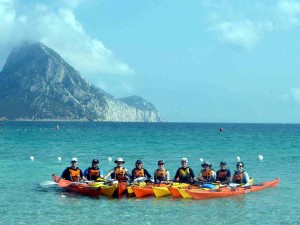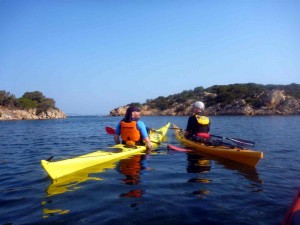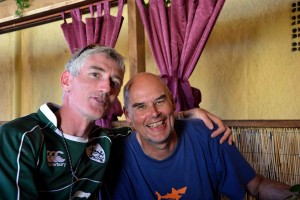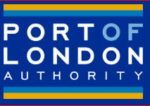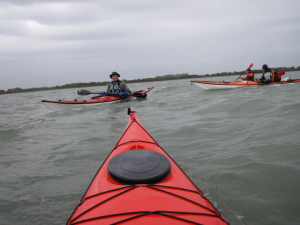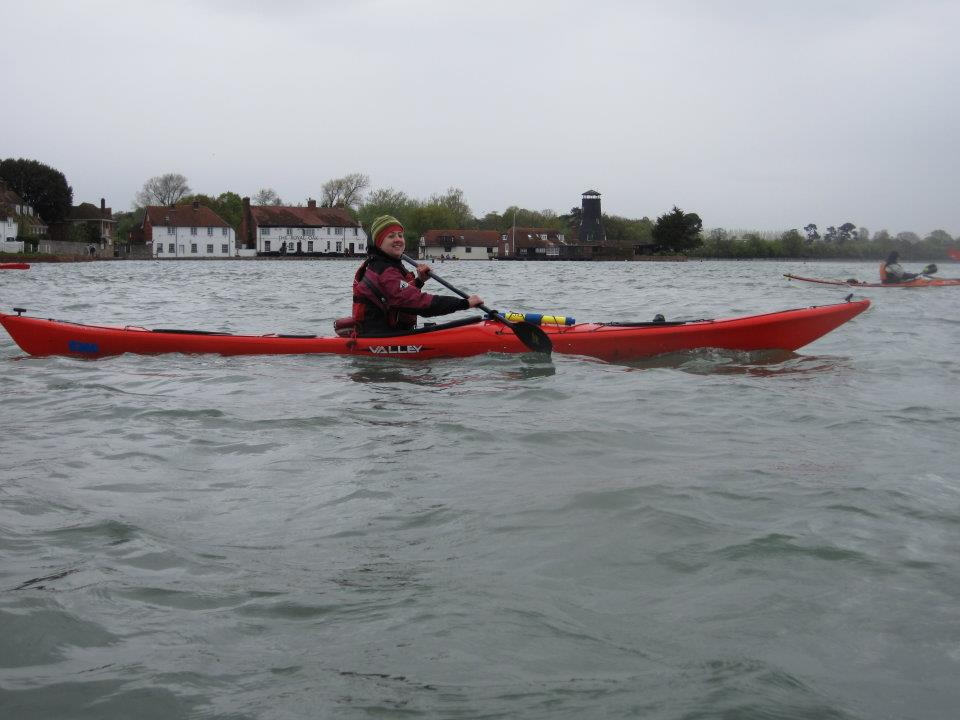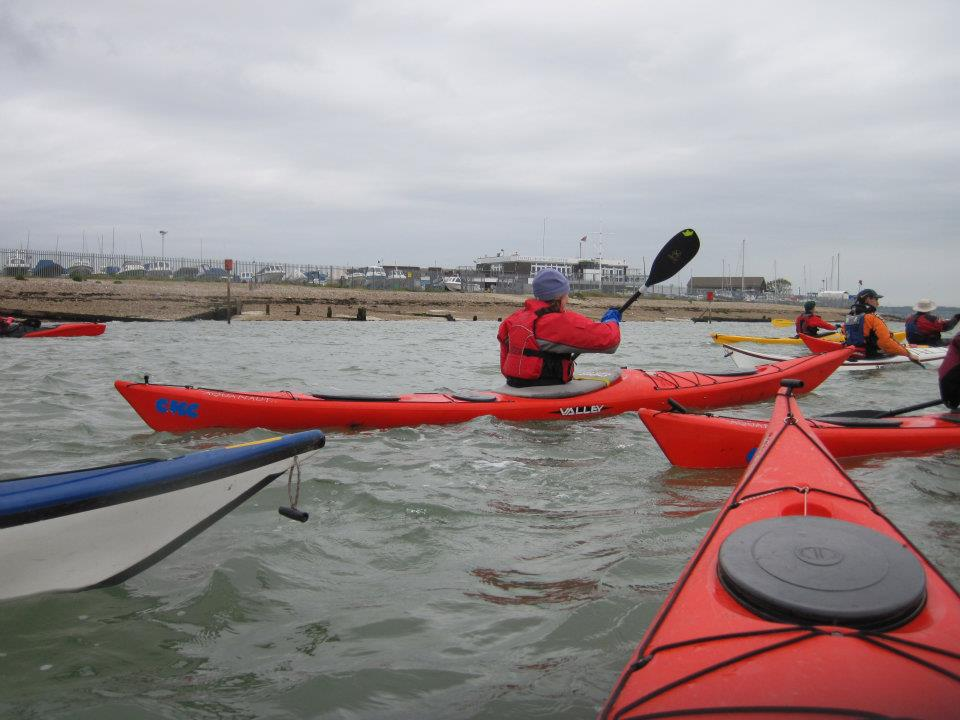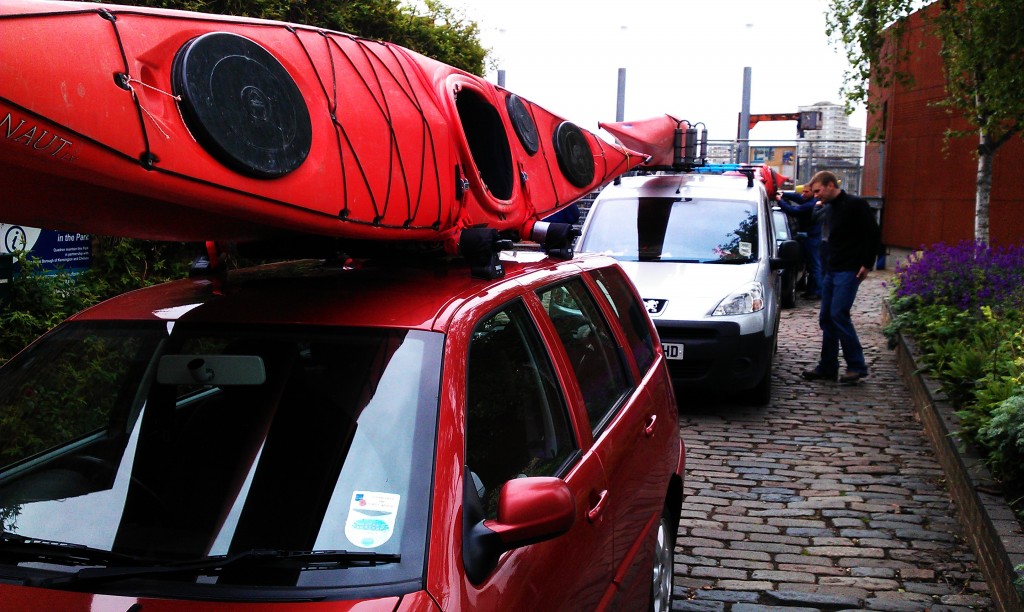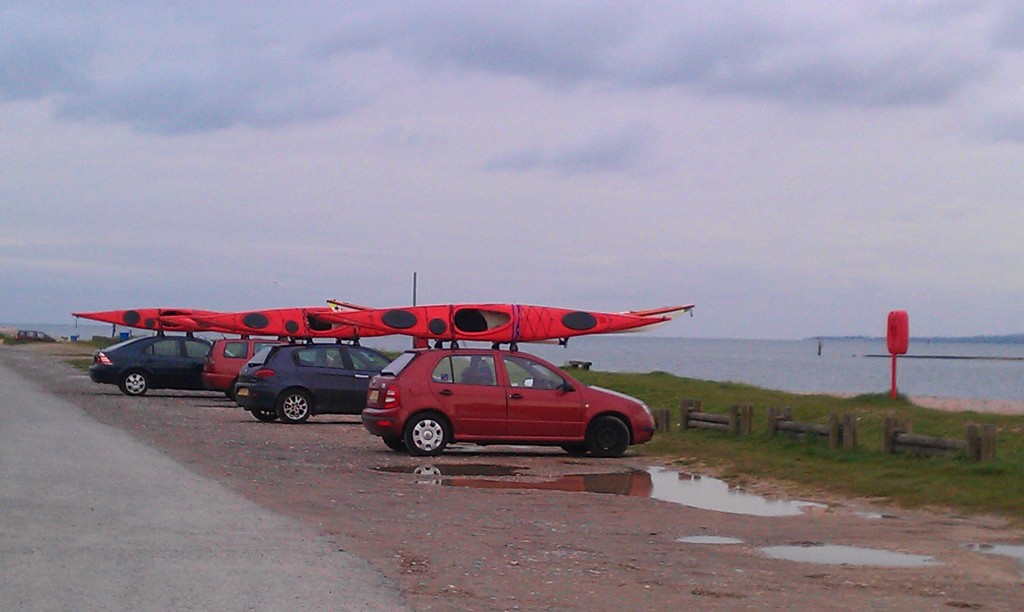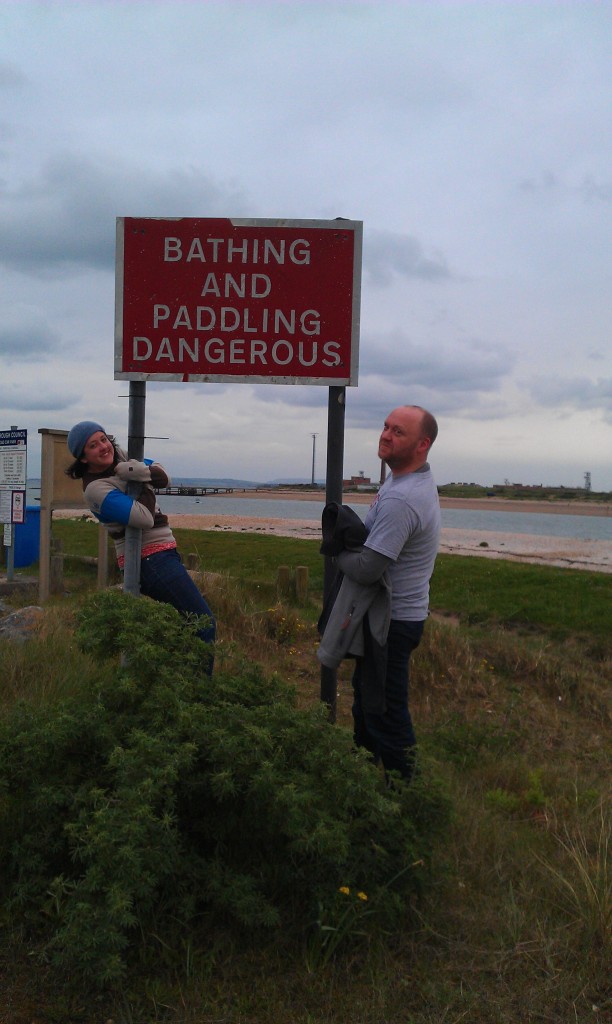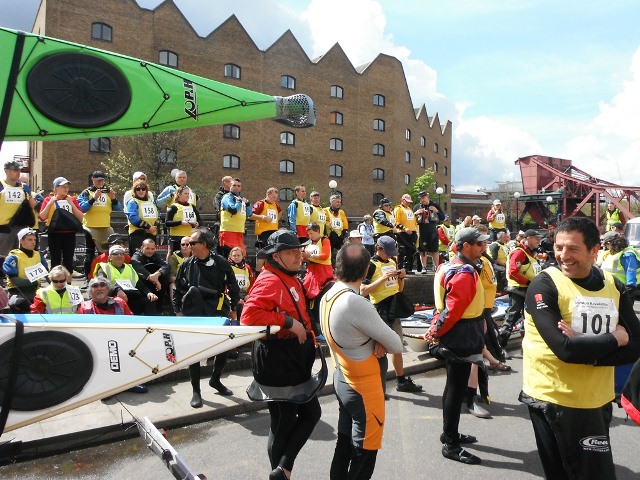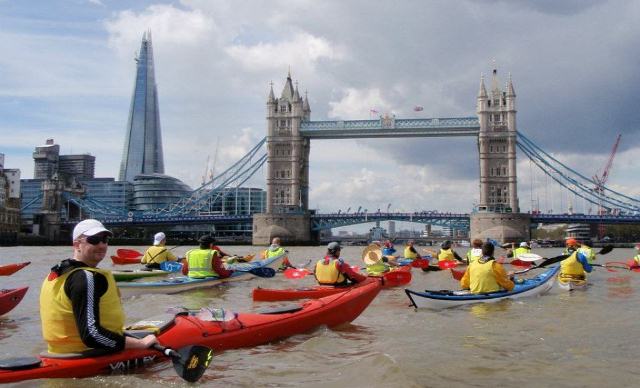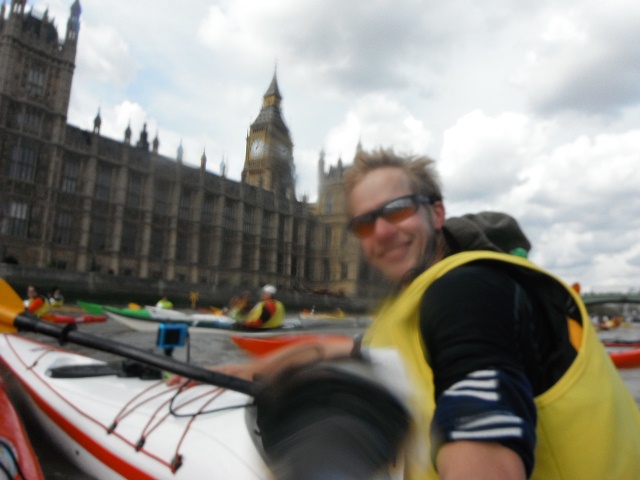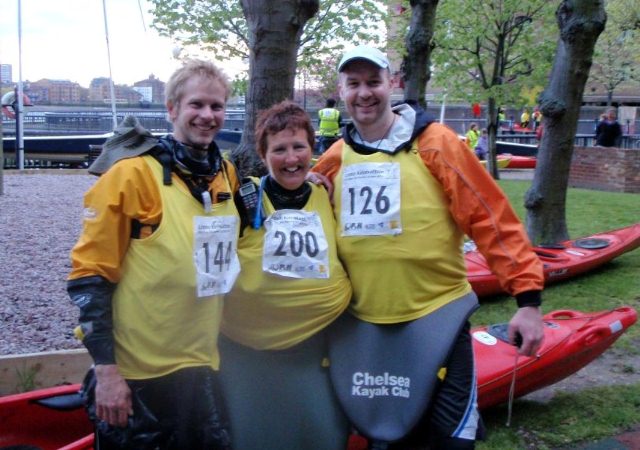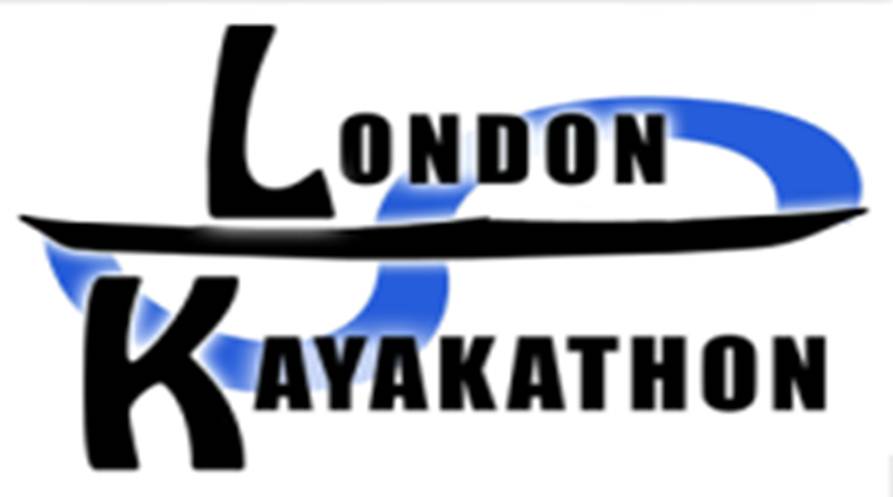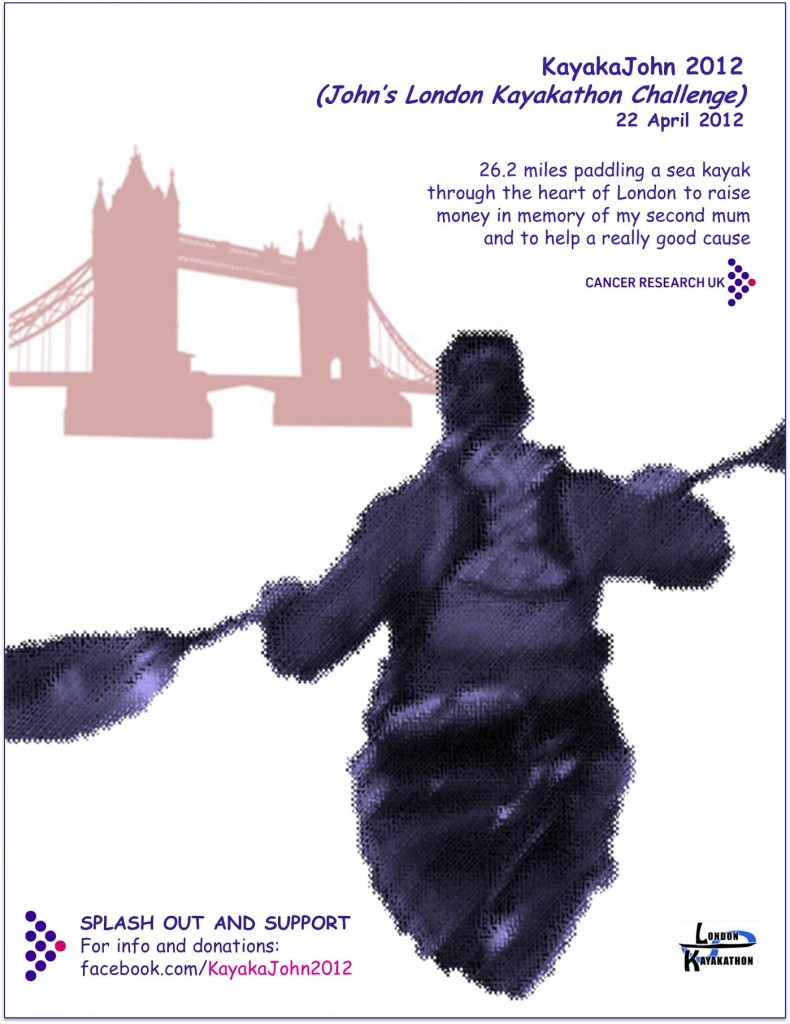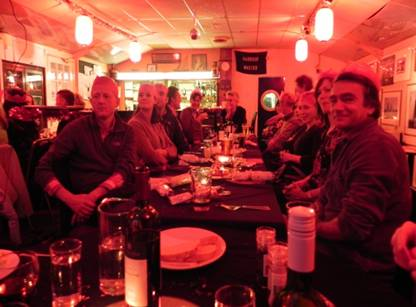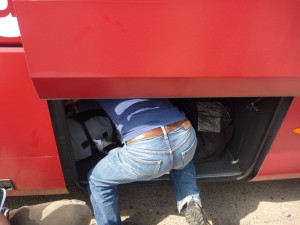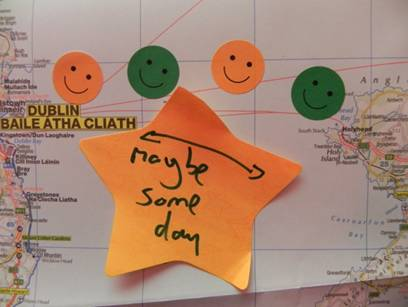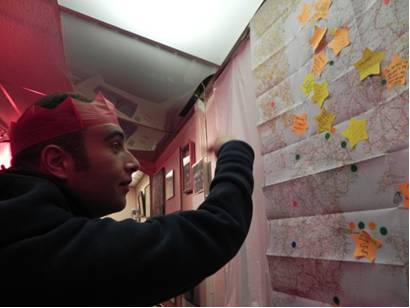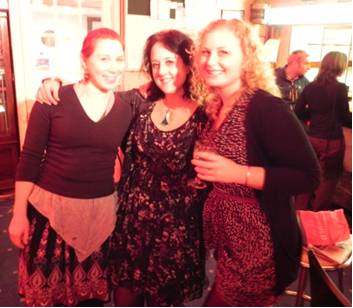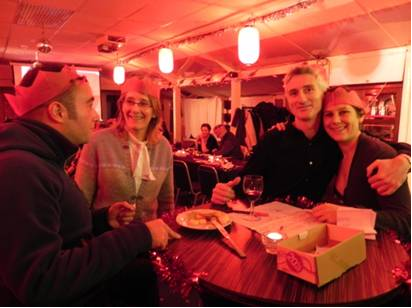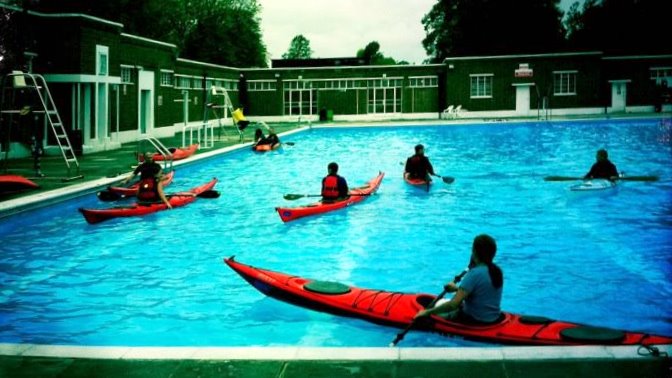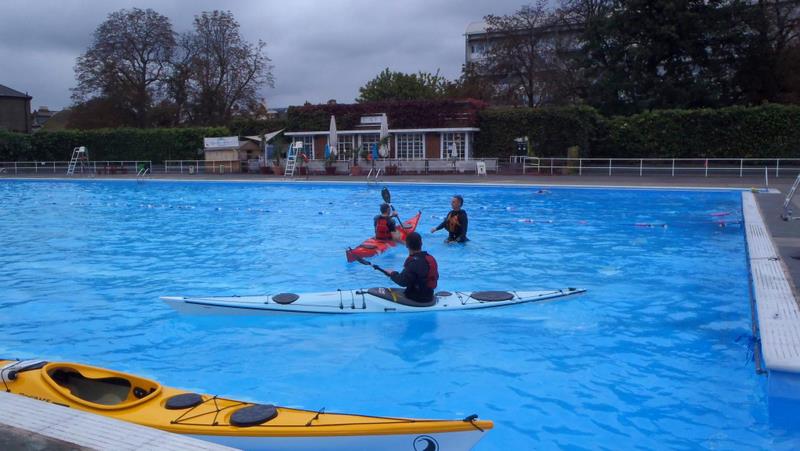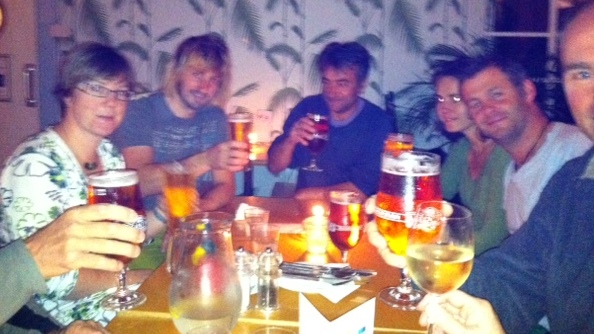9 (Instead of 11) Paddle Sardinia
Sitting at my desk, nursing a lemsip, reflecting on the first really chilly London day in December, I could swear that today, it actually started getting dark before it got light. It is therefore pretty tough trying to picture myself stretched out on the sand with a cold beer and a bunch of friends, watching the sun set over an idyllic cove in the north of Isola Maddalena. The photos, and the stories (one of which I was reminded of this afternoon in the pub, by Tim), convince me that it really did happen, less than three months ago, so I thought I’d share some of them to remind you that summer is real, it does happen, and there is another one just around the corner!
The first thing to mention was that it wasn’t quite as it should have been – Phil and Jacqui, whose inspiration the trip was, and whose hard work made it such a great trip, were not present. We missed them, it wasn’t the same without them, and not a day went by when I didn’t imagine what one or other might say or think of the sights and events we were experiencing.
So just 9 of us found ourselves at Camping Tavolara, on Sunday 25th September, making good headway into the expedition wine supply and having a gander at charts of the northwest coast of Sardinia, the Costa Smeralda, and the Maddalena Archipelago. Clark Weissinger, of Sea Kayak Sardinia, came to meet us at the campsite, with a selection of 9 excellent boats, and gave us a bit of a local lowdown over a glass or two of said wine, and a tune or two from Andy’s ukulele.
Day 1
Wind: F2 NE
Outlook: Sunny
Distance: 7 Nm (Andy and Richard 8Nm )
Set off: 1200
Broke Camp: 1600
A beautiful day to set out. Clark arrived to collect us at 0900 and after a pleasant shuttle in the van, listening to Christy Moore on the CD player, we were all down at the beach loading our kayaks (or drinking cappuccinos, for those who managed to cram a week’s worth of supplies into their boat first) against the dramatic backdrop of Isola Tavolara.
Our starting point was stunning – as we loaded the boats on the beach, the 5km x 1km limestone massif of Isola Tavolara sat temptingly in the near distance, with its highest point, Monte Cannone, beckoning us. We could have spent a couple of days just paddling this bay.
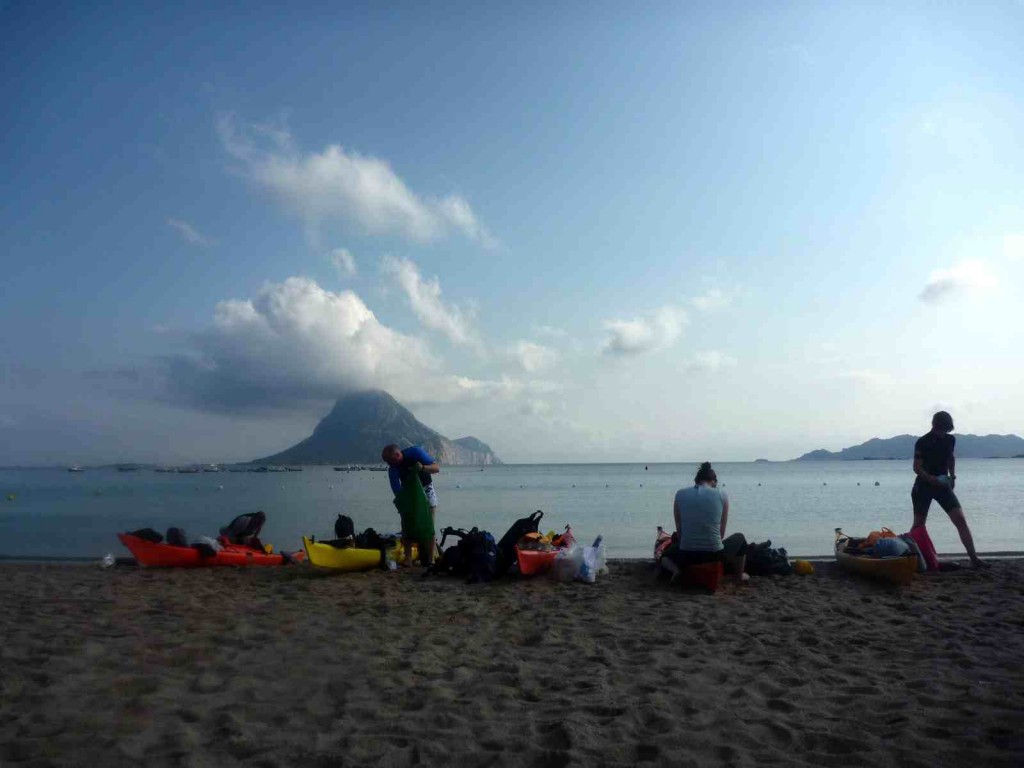
Loading up the boats before embarking on our expedition, Monte Cannone in the distance.
As soon as we got on the water, we paddled across for a gander, then headed to the spit at the western end for a quick swim and lunch, while Andy and Richard sprinted up to the other end of the island and back. Then we headed decisively off to get some distance under our belts. Until we saw the rusty orange wreck set beguilingly against the deep blue water on the near side of the bay, and we just had to have a little peek. Andy parked up and slipped into the water with his snorkel, a minor shriek from inside the upturned hull confirming that there was plenty of sea-life to see.
Idyllic flat calm conditions accompanied us alongside Isola Tavolara to the next headland, (lucky really, as we were spread out across the bay thinner than dripping on a wartime ration crust). We rounded the headland of Capo Ceraso. As the vast Gulf of Olbia opened up in front of us, we tried to establish the best crossing point.
Our Day 1 objective had been to reach the other side of the bay at least, and if there was time, press on round the next headland before camping for the night. My brain started doing neurotic sums. It was 1500, and the crossing would take at least an hour and a half, and we still had to paddle far enough towards the mouth of the estuary to make crossing the shipping lane as safe as possible. Then we had to find somewhere to camp, and we had absolutely no hints as to where potential wild campsites existed, bringing the total time before we could strike camp up to a possible 3 hours – half an hour after dark. Hmm. Just as my it’ll-be-fine holiday brain was telling my neurotic sum-doing brain to shut up the enjoy the paddle, Toons, who was leading for the day, announced a plan to start looking for a campsite immediately. (Ha. Neurotic sum-brain – smug grin).
Lucky – it took 45 minutes and 3 scenic little coves, with beaches all proudly displaying no camping signs, (one of which sported a shotgun hole), and 11 different threats in four languages, emphasising dire consequences, for us to realise that the best thing to do was ignore them.
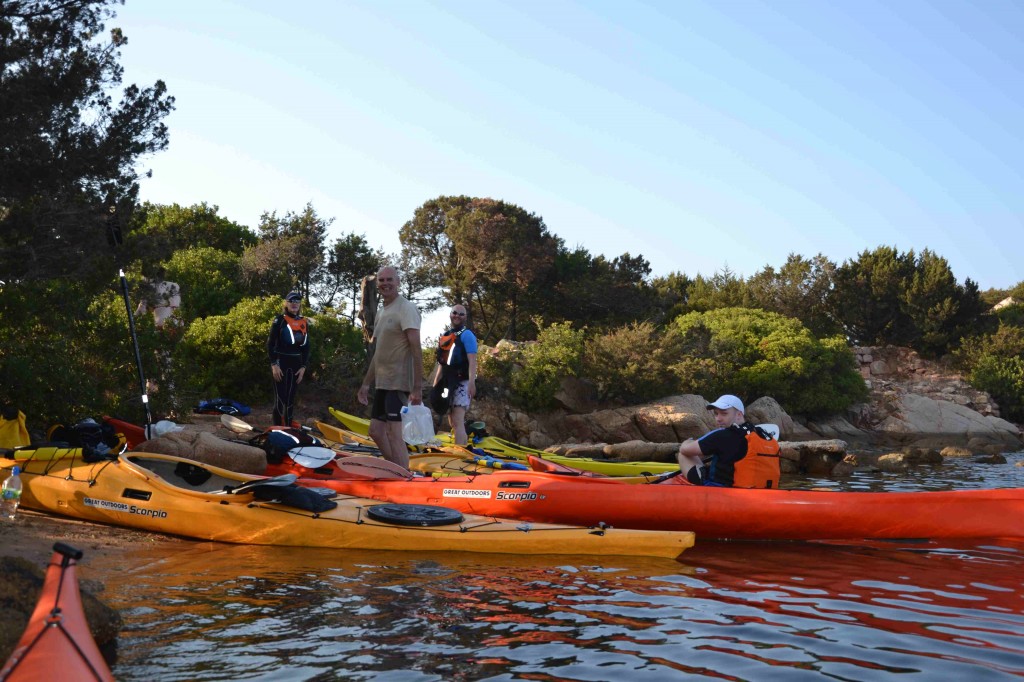
Our first night's camp spot - ignoring the signs
We landed, Lyn made coffee, then we pitched our tents (waiting till it was nearly sunset in view of potential dire consequences) and sat around chit-chatting about the stars, the day’s events, and generally how wonderful it was to be there. Andy started up a chat about the day’s paddle, which gave everyone a chance to reminisce about the best points from the day, and some areas they would like to improve on the next day. We did a little planning over grappa and more ukulele strumming, and headed to bed determinedly not dreaming of Italian policemen waving truncheons and shouting “vietato!” Little did we realise we would soon be doing some on-the-water negotiating with the Carabinieri regarding our paddling intentions…
Day 2. Olbia to Punto Canigione
F3-4 NW
Distance 21.6 km
Set off 1015
Arrived 1645
We set of at 1015 after a night free of law-enforcement. (Unless you count the mozzies). John led a tightly formed 3 x 3 box formation across the shipping channel (in which we came across two boats). We crossed the bay of Olbia in 50min and crossed again to reach Capo Figari at 1215. We lunched on the beautiful Isola Figolaro.
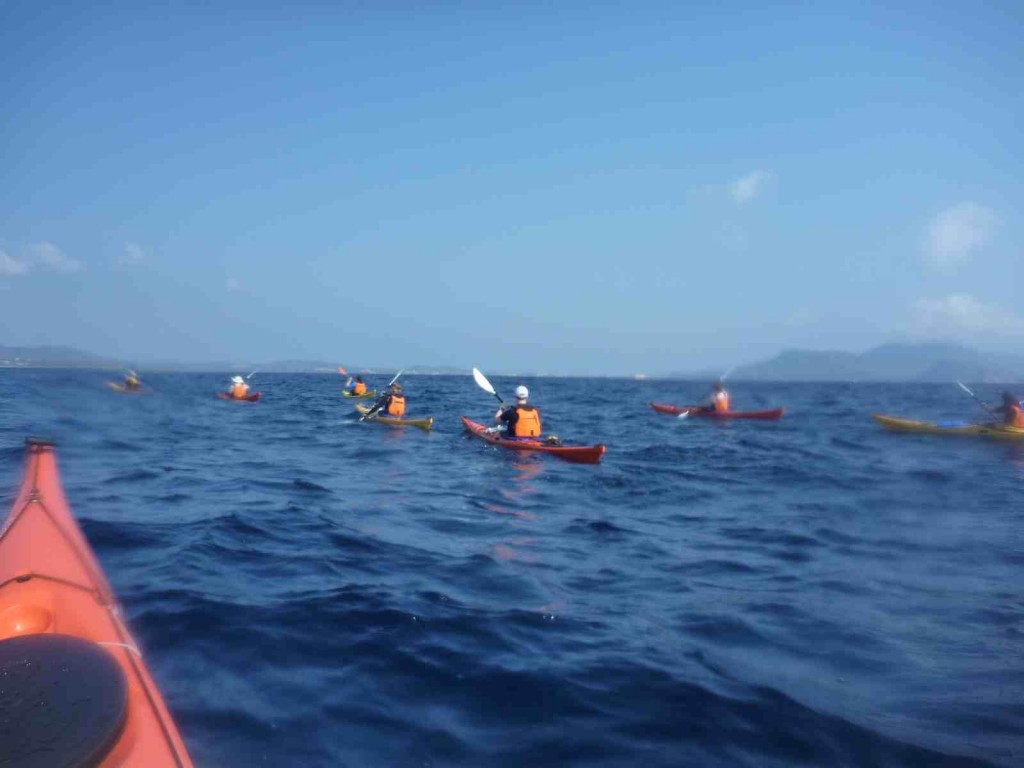
Box Formation
A gentle 1.5m high swell rolled us towards the headland of Capo Figari. It was friendly, but still swelly enough for a bit of post-lunch exhilaration. The headland was eventually rounded and we all accomplished totally pro surf landings on a small beach (OK, a little poetic licence of hindsight, but don’t forget it has been a few months and things are starting to take on a bit of a rosy glow), in order for Mel and Toons to recover from their seasickness, and then paddle off to rejoin Cynthia who was happily bobbing about in the bay waiting for us.
We pressed on, looking for somewhere to land for the night, and sent out a scout group, who found us a really lovely cove, with a nice sheltered beach for camping, and a good sized lagoon which was perfect for a Sardinian CKC skills session. John, Richard, Andy, Tim, Lyn and I all splashed about practicing our rolling, rescues and generally showing off, before deciding we were too tired for any more and getting off the water for the usual evening routine. (But not before Tim managed injury #1 of the trip by “sneezing a rib”).
We dug out the wine, (which strangely didn’t seem to diminish, even though by now we had run out of water and several of us had run out of food). I enviously eyed up Lynne and Mel’s “Look what I found” meal, while my pasta cooked, but was pleasantly surprised by my fresh gnocchi with cheese and za’atar (courtesy of Toons’ travel spice dispenser). After 2 days, Andy’s one man ukulele journey (which begun on our first night at Camping Tavolara, until when the instrument had been completely new to him), had already become a musical odyssey, and while we quaffed wine with the waves lapping at our feet, the music was a real treat. Especially as he hadn’t put his mind to mastering “I used to work in Chicago” yet…
Day 3
F 2-3 NE
Outlook: Sunny Visibility Poor-Moderate
Distance 20.3 km Temperature 26C
Set off 1000
Arrived 1640
Having covered good ground the day before, we didn’t go crazy with early starts on the Wednesday. We did need to restock with provisions though, so our first stop was just 5Km up the coast, the Marina at Porto Rotondo. After nestling our boats surreptitiously in a corner of the rather smart beach, we headed past the immaculately-clad yachties in the pristine marina, towards the village supermarket. It wasn’t exactly awash with bargains, with tuna at €13 a tin, but we managed to get some good grub.
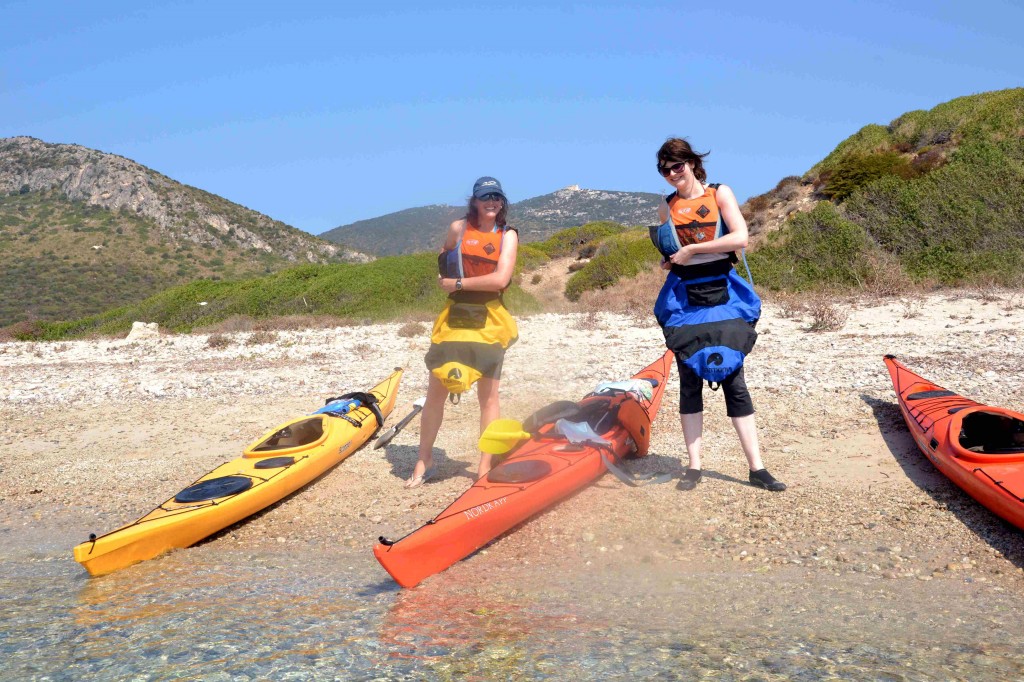
Mel and Lyn at our lunch stop
2 hours later, we set off across the bay, with a green domed peninsular as our destination, the white triangle at the tip eventually turning into a quaint whitewashed lighthouse. From there John and Cynthia in the lead set a cracking pace, and soon we were all well on our way to the next headland. After a couple of hours of blissful, quiet paddling over a broad, flat prussian blue sea, sparkling in the midday sunshine, Mel and Lyn answered a call from nature, which led us to a beautiful beach. It was lined with the flags of various nations, and had a smart white edifice in the middle, surrounded by sunbeds and parasols. We made for the secluded corner of the beach, where the shallow aquamarine bay was perfect for a quick dip – Richard jumped in, followed by Toons, who snorkelled up to the pontoon and found a shoal of brightly coloured fish. Lyn spotted some spiky sea urchins
– Tim: “Why did the razorbill raise her bill?”
– Cynthia: “So the sea urchin could see ‘er chin…” Sea – ur – chin… Gerrit?
We set off with Richard at the front, and rounded the Capriccioli headland, heads down, and core muscles engaged, expecting to be hit by the NE F4 wind and some choppy water, but neither materialised until later, when we had just rounded a deceptively small peninsula.
Up till now we passed mainly green hillsides covered in sprawling mansions, but here it changed, with spectacular rock formations coming right down to meet the sea. Toons, Andy and John headed over for some rock-hopping – no-one else was tempted initially, but as we passed on the inside of a particularly stunning rock formation, Lyn was lured in for a quick go.
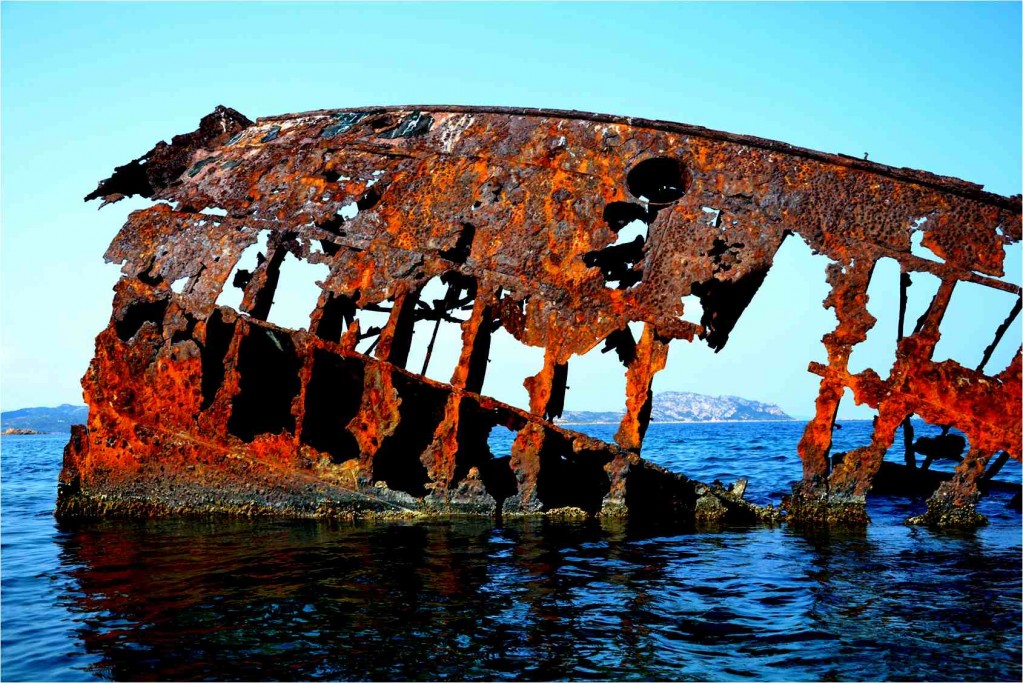
The Wreck
We continued North towards Porto Cervo. Rounding the Golfo Pevero headland we regrouped to make the call on whether to press on to Porto Cervo or head inland and find a camp spot. The Autumn sun was beautiful, and gave the seascape a silvery glow, but it was low in the sky, and making out any detail in the coastline was tough – hard to know if there might be any potential camp spots or not. Cynthia spotted a tempting looking beach on Isola Nibani, just off the coast, (later to be named Killer Mozzie Island), and she, Toons and Andy led an exploration.
Venturing slightly inland, the rest of us reccied the coast. To our left, only rocks. On the far side of the bay, tourist beaches, with just visible parasols. Cappuccinos, cold beer, calamari, spaghetti alla vongole (or “arselle” in Sardinia) and gelato miraged around our heads, and we gazed longingly towards the parasols.
Then the radio sprang to life with Andy’s voice:
“John, John this is Andy. Over.”
“Andy this is John. Over.”
“We have ID’d a site, safe landing, good camp site.”
“Andy this is John we are currently reccieing an alternative site, will advise. Over”
“Thanks. Will await further contact.”
“Andy, listening on 8, out”
The calamari-gelato mirage popped, and another perfect surf landing later, we were hoiking our kayaks up onto the steep beach of Isola Nibani, before pitching camp, while Tim repaired his tent and sustained his second injury of the trip (Calf Gouging).
After tea and chocolate, Lyn provided rosemary crackers and pecorino cheese, which we washed down with cold beer. Gazing out at the mainland in the near distance, the view was idyllic, with a beautiful rock formation bathed in the early evening Mediterranean sunlight. Punctuated only by shrieks of rage as Lilo Lyn discovered Andy raiding her floating sea-grass beer-fridge, as she bobbed around unsuspectingly on her lilo.
After Tim and I made a photographic tour of the Island, we all attempted to spend the evening in the communal area of our Nibani Island campsite, to dip into the wine stash and regale each other with the day’s stories. Sadly the swarm of mosquitos that arrived at sunset refused to leave us in peace, and most of the party managed a little “me time”. John, Tim and I bravely stayed up playing cards, drinking whisky and writing the journal but soon retired for a few quiet reflections on the day’s paddling.
Day 4NW 3-4 Easing in pm
Outlook: Sunny
Distance 29.9 Km
On the water for 0815. Big sigh of relief leaving the mozzies. We crossed NW toward the headland, just North of Porto Cervo, in moderately choppy water, and after an hour of paddling, a couple of Carabinieri motored up behind us.
– Carabinieri: “Bad sea, atennzione, atennzione. Where you go?”
– Tim: Chats cleverly away in his EuroTalian.
Carabinieri not too happy when we explained we were headed North to the Maddalena Islands, but Tim and Andy somehow managed to reassure them, and off we went. We subsequently discovered that three Welsh canoeists had been reported missing following an overnight trip on the South of the island that week, so the concerns were understandable, especially in view of the choppy seas. Happily the Welsh group were found safe and well.
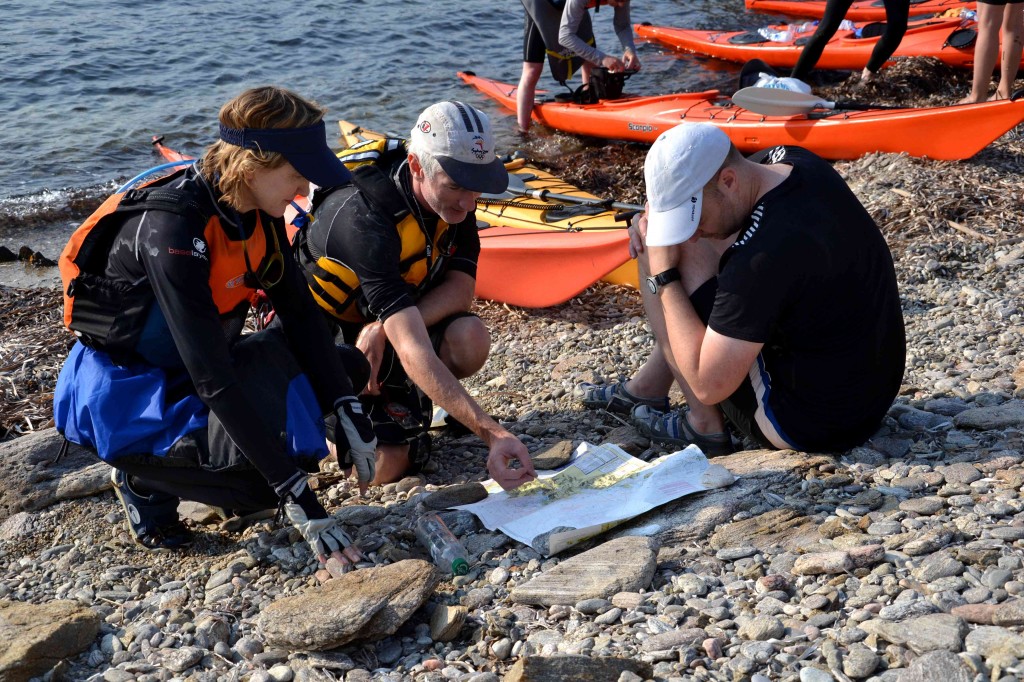
Andy, John and Cynthia plan our route round to our destination on the northern aspect of La Maddalena
Andy’s calm reassurance to the Police officer regarding our sea kayaking prowess was still ringing in the air when Mel’s piercing shriek of “Aagh a wave” made us all jump out of our skins. Fortunately the law enforcers were well out of earshot, and Mel managed to remain upright, despite a large wave coming out of nowhere to break over her head, shunting her a few feet sideways. It turned into yet another lovely paddle, and at 1000 we had a beach break on Isola della Bisce, then headed across a beautiful calm open stretch of water, encountering a yacht race, a sailing boat floundering with a twisted spinnaker, and a catamaran, before reaching Isola Caprera and turning North East to head up the channel to the Maddalena Archipelago.
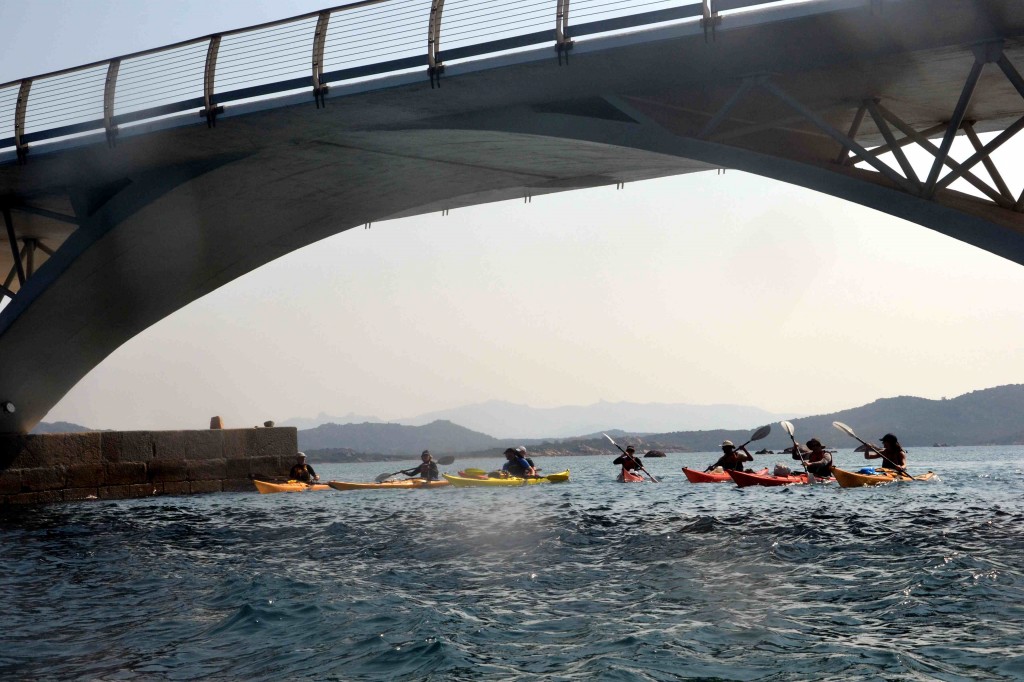
Paddling North Between Isola Caprera and La Maddalena
After 6 hours of paddling, we finally rounded the North aspect of Isola Maddalena into a beautiful quiet bay. With other priorities than finding a campsite, most of us headed to the beachside kiosk. Before joining everyone, I leapt into the turquoise water for a celebratory dip to wash away the salt crusts. Unwise as it transpired, as by the time I arrived at the jolly kiosk the beer was all gone! Aperol and prosecco spritzers made up for it though, after which we stumbled across the bay to find our spot for the night. Richard and I jumped in for a swim, and watched the stunning sunset from the water, through the golden blanket of sea, punctuated with little domes of dark blue-black fluttering through the surface. We looked up and saw Toons and Andy, silhouetted under a red crescent moon, chatting about Andy’s planned paddle to Corsica in the morning.
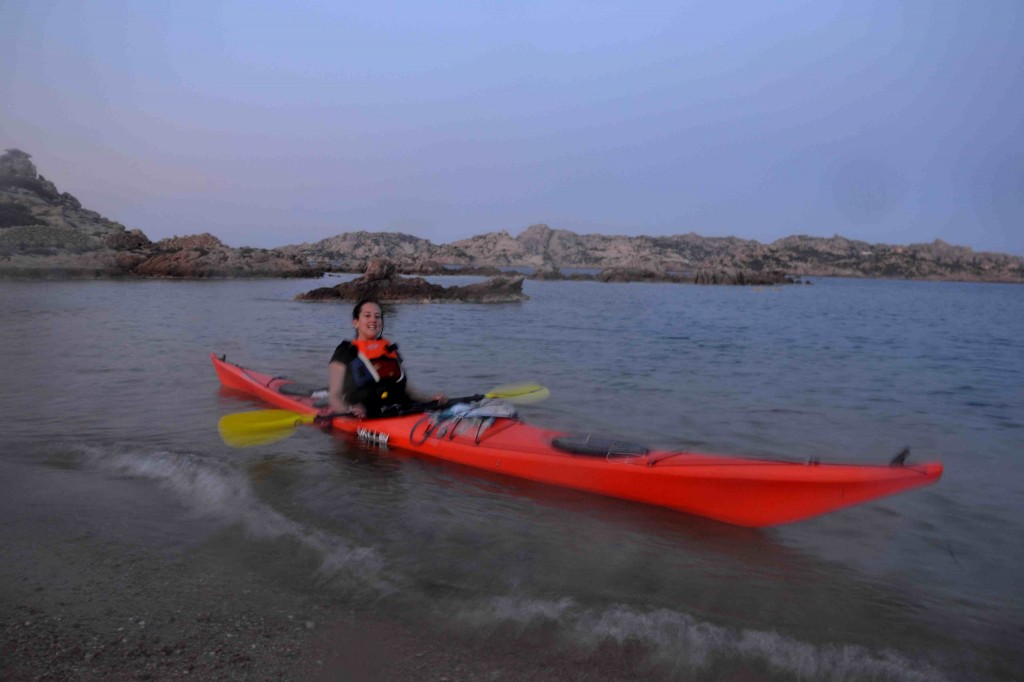
Paddling Until Last Light!
Day 5
The next two days were spent relaxing in the gorgeous islands. On Friday, Andy sprinted to Corsica, only to find it was shut. Toons and I enjoyed a lazy day, with a short trip round the coast, getting there just in time for a swim followed by a beautiful sunset paddle back to the campsite, to discover Andy relaxing on the beach after his epic journey. John led an energetic trip to the outer islands, (uncovering James Bond’s secret hideout) during which an exhilarating time was had by all. Mel, Tim and Lyn went for the trekking option, and hit the town of La Maddalena
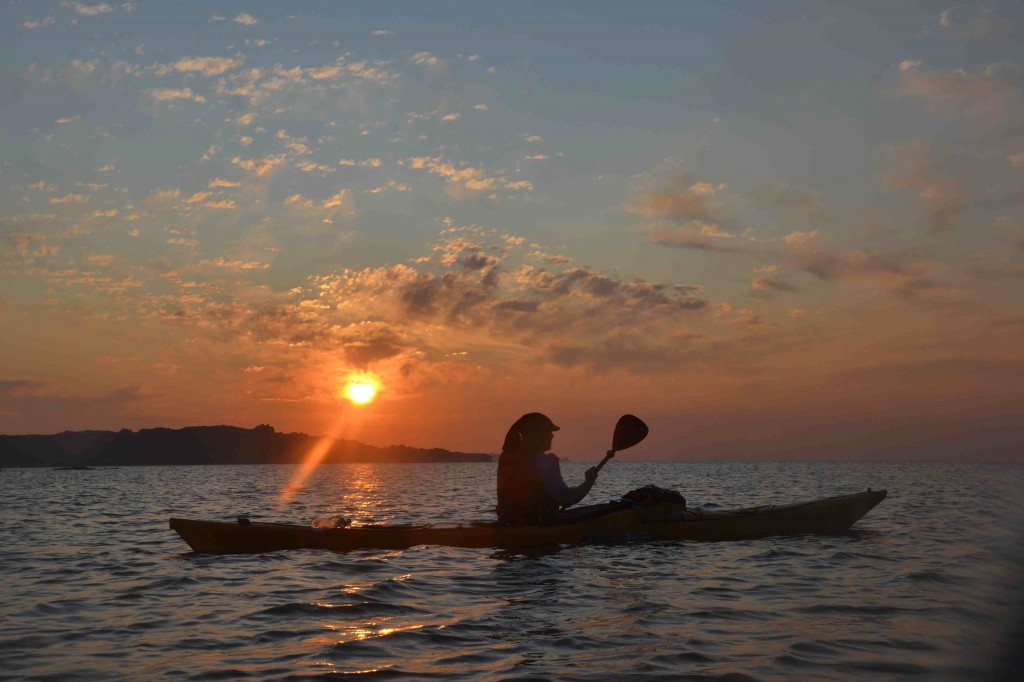
Toons Paddling Back at Sunset
Day 6
NE 2-3
Distance 14 Km
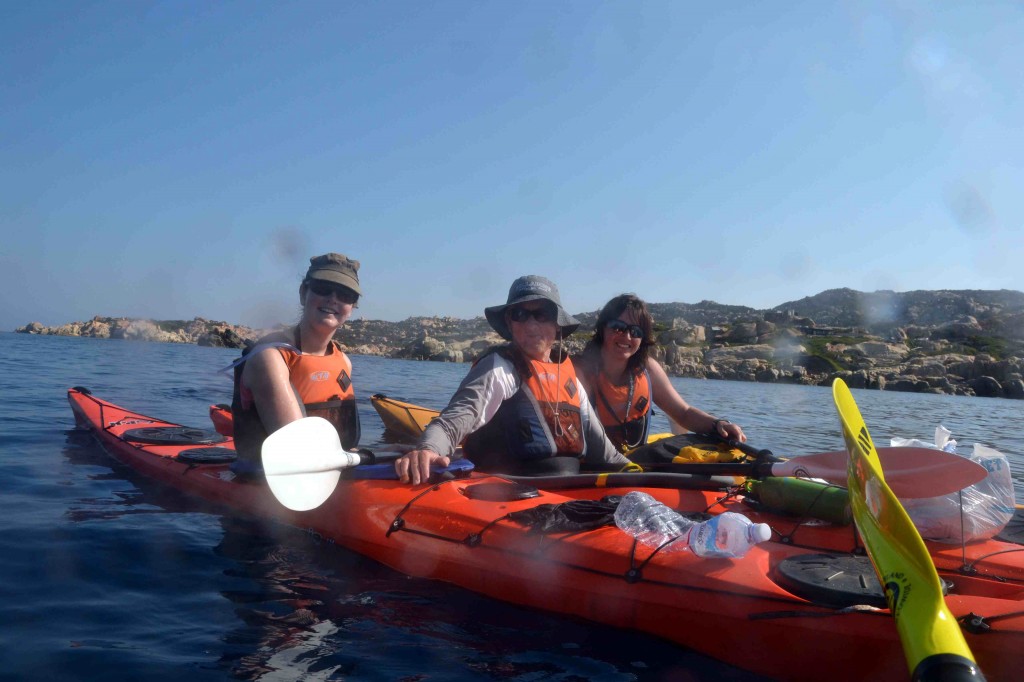
Paddling back on the last day
The dawn broke over a brilliantly sunny sky for our last idyllic Mediterranean paddle back down to the mainland along the west coast. We made fantastic time – 6km/hr, due to flat calm conditions. After 5km of coastline we started looking in earnest for a spot for a quick swim. We were astounded when we reached La Maddonnetta del Pescatore, a little church right on the edge of the water. Andy moored his boat, and, well, see the photo for details…

Andy Summits La Madonnetta
We eventually found our swimming beach, before rounding the south aspect of the island into the busy shipping channel between La Maddalena and the mainland, which we crossed without incident, past all the ferries going in and out of Palau. We parked up at the end of a beautiful sea lido, and skipped up some stone steps to a restaurant for a celebratory meal of pasta, red wine and fish before being scooped up by Clarke and driven back to Tavolara.
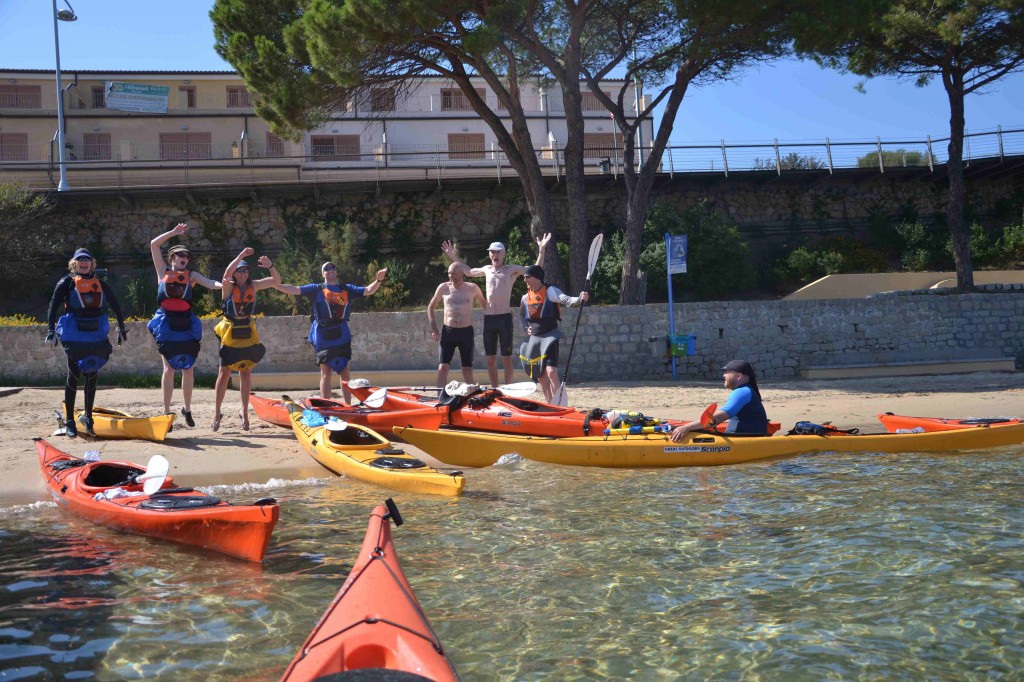
Arriving at our final destination - the beachside lido in the port of Palau!
Once there, Tim, Andy, Toons and I sped down to the beach for a last cappuccino and ice cream, to find that the beachside restaurant was boarded up, with the proprietor stacking up chairs inside ready for the winter. He smiled and shook his head, and with a dismissive wave of his hand, suggested, “l’anno prossimo!”.
L’anno prossimo it is…
Miranda
